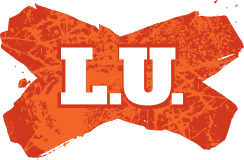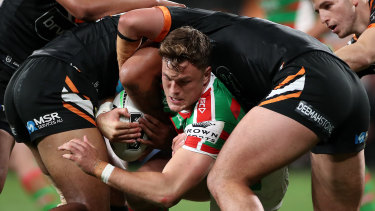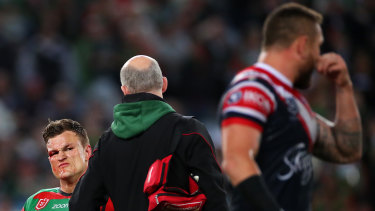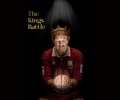Liam Knight is unfortunately an example of when taking the "she'll be right attitude" is not a good idea.
South Sydney prop Liam Knight has admitted he hid concussion symptoms and continued to train for two months before finally opening up to the club about the extent of his debilitating migraines last week.
In the same week Sydney Roosters’ co-captain Jake Friend retired because of too many concussions, Knight spoke for the first time about his struggles with the effects of a headknock suffered during the pre-season.
Knight, who has not played a game this season and has now stopped training indefinitely, clashed heads with teammate Tom Burgess at a Rabbitohs contact session.
Liam Knight has struggled the past two months with migraines.Getty Images
Originally slated for a round-two return, Knight has now been advised by the club’s medical staff and a neurologist to stop training altogether in a bid to finally overcome his symptoms.
Knight, 26, originally thought if he could ignore the migraines long enough they would pass, and even admitted to making the mistake of hiding his symptoms from teammates and Souths’ medical staff.
He only came clean last Tuesday when the migraines started after a gruelling field session last Tuesday.
“I tried to train through the pain but the more I trained the worse the migraines became – it was like it was stuck on repeat for weeks,” Knight told the
Herald.
“It was my fault because I kept training thinking I’d be OK and didn’t say anything to anybody about the symptoms. I finally told the boys when it all became too much last week.
Liam Knight stares down Jared Waerea-Hargreaves after he was concussed at the end of 2019.Getty Images
“I now realise you have to do nothing to do something.
“I haven’t trained in a week. I can’t even lift weights. I just don’t feel right and feel fuzzy. I’d start training and I’d be fine, but the headaches would start afterwards.
“It’s now up to me when I train again. I’m waiting to be symptom free. I was putting pressure on myself to get back, but the club were like, ‘relax’, and told me not to rush.
“It’s been an awful time to be honest. It’s actually been a f---ing nightmare. All I want to do is train and play.”
Knight clashed heads with fellow front-rower Burgess during a training drill and initially thought he would only miss the Charity Shield.
Souths gave him extra time and even spared him the round-trip to Melbourne, but his condition did not improve.
Knights’ admission comes after a recent study of NRL players discovered one in five players had
hidden a likely concussion from a team doctor for fear of missing matches or letting down teammates and coaches.
A paper published in the
British Journal of Sports Medicine – and prepared by respected Sydney-based sports doctor Tom Longworth – claims 22 per cent of NRL players surveyed anonymously confessed to not reporting at least one likely concussion during either the 2018 and 2019 season.
The most popular reason for not reporting a likely concussion was “not wanting to be ruled out of a game or training session” (57.7 per cent) followed by “not wanting to let coaches or teammates down” (23.1 per cent).
The only previous concussion Knight suffered was a sickening blow against the Sydney Roosters in 2019, which saw Jared Waerea-Hargreaves charged, but he was later cleared at the judiciary.
Knight was excited for a big year and the chance to join the likes of Jai Arrow as part of an imposing middle-forwards rotation.
Knight said he felt for Friend having to step away from football but remains confident he will be able to fully recover with enough time to recuperate.
“You naturally feel very empathetic about that situation (Friend’s retirement), and nobody wants to see a player’s career cut short,” Knight said.
“I was thinking it was [all over] at one stage, but I spoke to a few boys who had gone through the same thing, and how it took them a while before they were sweet.
“I just need to be patient. It’s just hard when the boys are going so well because you want to be a part of it.″
Knight is signed until the end of 2023 and ignored a bigger-money deal from the Gold Coast Titans because he felt Souths have the roster to win a premiership the next few years.
Bennett recently said about Knight: “He keeps getting mild headaches and things at the moment, he won’t be available this week, and I don’t think he’ll be available next week [for the Broncos] - we’re not sure how far he is away.
“He is frustrated, but he is handling it and managing it as he has to. He doesn’t have an alternative.”
https://www.smh.com.au/sport/nrl/it...p-s-concussion-nightmare-20210406-p57gxs.html




